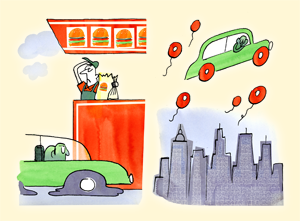Driving on underinflated or overinflated tires?

Correct air pressure has puzzled motorists since André Michelin first tried the air-filled tire on an automobile in 1895. Tires, service, and air-pressure gauges have improved considerably since then.
Jim Lee, owner of Campus Auto & Tire on Brooklyn Street in Gambier, contemplated the question of inflation in his back-to-back twobay garage, where he also sells eggs produced by his Mount Vernon chickens. "Underinflated is worse," Lee said.
"You're not going to get good tire wear and you'll get worse fuel economy" with an underinflated tire, Lee said. The underinflated tire loses its shape and flattens out on the road. "The wear is going to be riding on the shoulders of the tire, instead of flat across like it should be." Steering and stability while turning a corner can also be affected by an underinflated tire. Lee noted that tires can lose some air pressure during extremely cold weather.
"When a tire gets low, especially low, the rim will actually start eating the tire." That's why motorists should pull over as soon as safely possible when a tire goes flat on the road.
The overinflated tire may make for a rougher ride and be more vulnerable to damage caused by potholes, and may wear unevenly. More wear in the center of a tire can indicate an overinflation problem.
Lee sees more underinflated tires than overinflated. And he reminds motorists that a visual inspection is no substitute for actual measurement with a tire gauge. But it is worth visually inspecting the sidewall of each tire, where the correct air pressure is printed. Lee advises motorists to have the air pressure in tires checked during regular maintenance visits.
The lesson here: Don't be caught flat-footed.
—Mark Ellis

 Delicious
Delicious Facebook
Facebook StumbleUpon
StumbleUpon Digg
Digg reddit
reddit